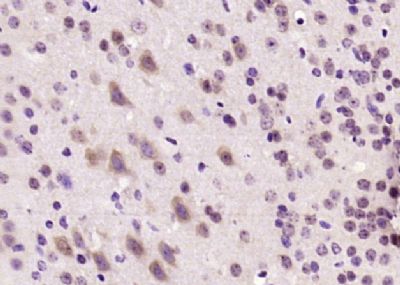Microcephalin 1/BRIT1 Polyclonal Antibody
Purified Rabbit Polyclonal Antibody (Pab)
- 产品详情
- 实验流程
Application
| WB, IHC-P, IHC-F, IF, ICC, E |
|---|---|
| Primary Accession | Q8NEM0 |
| Reactivity | Dog |
| Host | Rabbit |
| Clonality | Polyclonal |
| Calculated MW | 92849 Da |
| Physical State | Liquid |
| Immunogen | KLH conjugated synthetic peptide derived from human Microcephalin 1/BRIT1 |
| Epitope Specificity | 11-110/835 |
| Isotype | IgG |
| Purity | affinity purified by Protein A |
| Buffer | 0.01M TBS (pH7.4) with 1% BSA, 0.02% Proclin300 and 50% Glycerol. |
| SUBCELLULAR LOCATION | Cytoplasm, cytoskeleton, centrosome. |
| SIMILARITY | Contains 3 BRCT domains. |
| SUBUNIT | Contains 3 BRCT domains. |
| DISEASE | Defects in MCPH1 are the cause of microcephaly primary type 1 (MCPH1) [MIM:251200]; also known as true microcephaly or microcephaly vera. Microcephaly is defined as a head circumference more than 3 standard deviations below the age-related mean. Brain weight is markedly reduced and the cerebral cortex is disproportionately small. Despite this marked reduction in size, the gyral pattern is relatively well preserved, with no major abnormality in cortical architecture. Primary microcephaly is further defined by the absence of other syndromic features or significant neurological deficits. This entity is inherited as autosomal recessive trait. |
| Important Note | This product as supplied is intended for research use only, not for use in human, therapeutic or diagnostic applications. |
| Background Descriptions | Microcephalin modulates brain size and has been proliferating under strong positive selection for several thousand years, although the nature of the positive selection is poorly understood. Human Microcephalin contains three BRCA1 C-terminal (BRCT) domains and shares 57% identity with its mouse ortholog, the most conserved regions being BRCT domains where there is 80% identity. Predominant expression of human Microcephalin is observed in fetal brain, liver and kidney tissues and is expressed during neurogenesis in mice. Microcephalin displays significantly higher rates of protein evolution in primates than in rodents; this trend is most noticeable for the subset of genes associated with nervous system development. Microcephalin has a very young, single nucleotide, polymorphism haplotype associated with modern humans; this gene is presumably still evolving in Homo sapiens. It functions in DNA damage response and regulation of cell cycle checkpoints. |
| Gene ID | 79648 |
|---|---|
| Other Names | Microcephalin, MCPH1 (HGNC:6954) |
| Target/Specificity | Expressed in fetal brain, liver and kidney. |
| Dilution | WB=1:500-2000,IHC-P=1:100-500,IHC-F=1:100-500,ICC=1:100-500,IF=1:100-500,ELISA=1:5000-10000 |
| Format | 0.01M TBS(pH7.4) with 1% BSA, 0.09% (W/V) sodium azide and 50% Glyce |
| Storage | Store at -20 °C for one year. Avoid repeated freeze/thaw cycles. When reconstituted in sterile pH 7.4 0.01M PBS or diluent of antibody the antibody is stable for at least two weeks at 2-4 °C. |
| Name | MCPH1 (HGNC:6954) |
|---|---|
| Function | Implicated in chromosome condensation and DNA damage induced cellular responses. May play a role in neurogenesis and regulation of the size of the cerebral cortex. |
| Cellular Location | Cytoplasm, cytoskeleton, microtubule organizing center, centrosome |
| Tissue Location | Expressed in fetal brain, liver and kidney. |
Research Areas
For Research Use Only. Not For Use In Diagnostic Procedures.
Application Protocols
Provided below are standard protocols that you may find useful for product applications.
终于等到您。ABCEPTA(百远生物)抗体产品。
点击下方“我要评价 ”按钮提交您的反馈信息,您的反馈和评价是我们最宝贵的财富之一,
我们将在1-3个工作日内处理您的反馈信息。
如有疑问,联系:0512-88856768 tech-china@abcepta.com.
¥ 1,500.00
Cat# AP54430























 癌症的基本特征包括细胞增殖、血管生成、迁移、凋亡逃避机制和细胞永生等。找到癌症发生过程中这些通路的关键标记物和对应的抗体用于检测至关重要。
癌症的基本特征包括细胞增殖、血管生成、迁移、凋亡逃避机制和细胞永生等。找到癌症发生过程中这些通路的关键标记物和对应的抗体用于检测至关重要。 为您推荐一个泛素化位点预测神器——泛素化分析工具,可以为您的蛋白的泛素化位点作出预测和评分。
为您推荐一个泛素化位点预测神器——泛素化分析工具,可以为您的蛋白的泛素化位点作出预测和评分。 细胞自噬受体图形绘图工具为你的蛋白的细胞受体结合位点作出预测和评分,识别结合到自噬通路中的蛋白是非常重要的,便于让我们理解自噬在正常生理、病理过程中的作用,如发育、细胞分化、神经退化性疾病、压力条件下、感染和癌症。
细胞自噬受体图形绘图工具为你的蛋白的细胞受体结合位点作出预测和评分,识别结合到自噬通路中的蛋白是非常重要的,便于让我们理解自噬在正常生理、病理过程中的作用,如发育、细胞分化、神经退化性疾病、压力条件下、感染和癌症。






